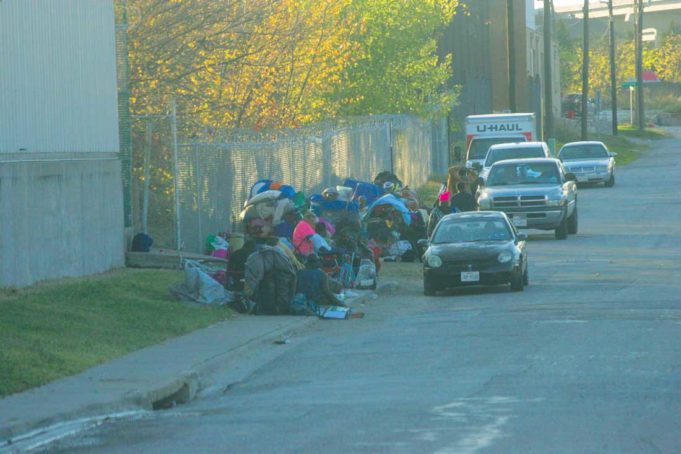Fleeing her dangerous ex-husband left Tonja with little choice but to live out of a car with her two children. It was late 2016 and near freezing. They spent the next three months at Presbyterian Night Shelter on East Lancaster Avenue. She was grateful for the help, but the experience was humbling.
“I’ve always been independent,” said Tonja, who asked to go by her first name only for her protection. “I had held many jobs” until then.
One day, the Detroit native said, she’ll return to work in criminal justice, a field in which she holds an associate’s degree. For now, she is making the most of the opportunities that Fort Worth’s homeless-focused groups have afforded her, she said. She is enrolled in a rapid re-housing program that is funded by Fort Worth’s 10-year initiative to end chronic homelessness. The city-funded Directions Home, partly managed by the nonprofit Center for Transforming Lives, provides rental assistance, financial counseling, and job placement services to homeless individuals.
“They helped me with anything I asked for,” Tonja said. “I didn’t have to buy things. They lessened my bills. When it came to school supplies and uniforms, I didn’t have to worry.”
The aid meant less stress for her family, she said, and the help has allowed her to focus on her future and to begin leaving her traumatic past behind.
Directions Home is nearing its final year. The program was created by Fort Worth City Council to make homelessness “rare, short-term, and non-recurring” in Fort Worth.
The program has received more than its fair share of praise and criticism over the past eight years. The Fort Worth Weekly regularly fields complaints from local residents who believe the homeless resources provided by the city and the network of shelters operating along East Lancaster attract vagrants and panhandlers from North Texas and beyond.
Wanda Conlin, president of the East Fort Worth Business Association, said the biggest concern voiced by the 100 members of her economic development group is the number of homeless individuals who congregate in and around East Lancaster. When introducing potential business owners to the area, she said, the first question on their minds is, “Where are the shelters?”
“They won’t go past Oakland Boulevard,” she said, referring to the road that is commonly perceived as the dividing point between the homeless shelters and residential neighborhoods to the east. “There has never been enough political will to make [the Directions Home program] work.”
The current homeless count in Fort Worth is 1,594, according to the Tarrant County Homeless Coalition (TCHC). TCHC did not record Fort Worth’s homeless population during the early years of Directions Home, but the nonprofit’s records do show a slight decrease in the overall homeless population of Tarrant and Parker counties between 2009 (2,169) and 2017 (1,924).

Tara Perez, Directions Home manager, notes that the overall homeless population in Tarrant County has lowered from an all-time high of 2,425 in 2014 despite booming population growth, stagnant wages, and a shortage of affordable housing. Since the program’s inception, it has placed 2,216 individuals in temporary or permanent housing, Perez said. Directions Home currently funds permanent supportive-housing vouchers for 115 individuals, including Tonja.
Major cities across the United States have recently made gains in lowering homeless numbers. Houston saw a nearly 70-percent reduction in chronic homelessness numbers and a 50-percent reduction in overall homelessness between 2011 to 2016, according to Houston public information officer Jocklynn Keville. Much of that success is credited to city leaders who, with the help of private businesses and churches, provided more than 4,000 housing units for the local homeless population.
Last year, Austin Mayor Steve Adler announced that the city had “effectively ended veteran homelessness.”
Perez said there are many lessons that Fort Worth can learn from its neighbors.
With $22 million invested from Fort Worth coffers and time running out, Perez has an ambitious plan to make the most out of Directions Home’s final year. Though still in the early stages of discussion through a volunteer body known as the Continuum of Care Planning Council, the idea is to create a board that represents the city, county, shelters, and all nonprofit groups currently addressing homelessness.

Fort Worth was one of the last major cities in the United States to adopt a 10-year plan to end homelessness. Unlike other large cities, there was a lack of political will from Fort Worth City Council to form a plan to end homelessness. But Fort Worth would eventually catch up to the other cities that were inspired to act by the National Alliance to End Homelessness, the nonprofit that released its ambitious blueprint for ending homelessness, A Plan, Not a Dream: How to End Homelessness in Ten Years, in 2000. Three years later, the U.S. Department of Housing and Urban Development, with the support of then-President George W. Bush, released similar guidelines and strategies and challenged cities across the United States to create 10-year plans of their own. Otis Thornton drafted much of Fort Worth’s plan 10 years ago.
His area of expertise? Housing.
Thornton managed the program as Fort Worth homeless program coordinator until he replaced Cindy Crain as executive director of TCHC in 2015. He recently resigned from that position and moved to Tennessee.
“We were late to the game,” Thornton told me.
In 2005, Fort Worth Mayor Mike Moncrief was under pressure from neighborhood groups and homeless advocates to provide a strategic framework to address homelessness. The 19-member Mayor’s Advisory Commission on Homelessness was created that year, tasked with proposing solutions. In 2006, the commission, with the help of Thornton, began drafting early versions of the Directions Home program.
“We did a lot of exploratory research, held public hearings, gathered data, and discussed [our findings] in smaller groups,” Thornton recalled. “Then I would draft the language” and send it to the commission for approval.
Directions Home was approved by Fort Worth City Council in mid-2008. With an annual budget of a little more than $2 million, the plan was ambitious. The Directions Home annual budget has since increased to $3.1 million.
“The city rolled up its sleeves and began to take proactive action in a way that was fairly unprecedented,” Thornton said. “That was a big thing.”
Today, the program funds four rapid re-housing programs, 19 full-time case managers, and job readiness and housing voucher programs.
“We housed 1,500 people in the first five years,” Thornton said.
City records, however, put the number at 1,167.
“In the years after that, the numbers went up even more rapidly,” he said. “In some cases, we saved lives. In other cases, we enabled people to die with dignity within housing.”
But by 2014, the program fell under public scrutiny. That was when TCHC reported a four-year high in the county homeless population. On April 15 of that year, the Fort Worth City Council appointed an ad hoc taskforce to advise City Council on opportunities to “streamline the funding and delivery of services to homeless persons in Fort Worth.”
Donald Boren served on that taskforce.
“Basically, our elected officials were not happy with the progress,” he said. “There were good people working on [Directions Home], but the program was floundering.”
Boren credits the taskforce with restructuring the Directions Home program so its directors report directly to Fort Worth Assistant City Manager Fernando Costa. The program’s office was moved next to the city manager.
Today, Fort Worth has between 220 and 400 chronically homeless individuals, according to Perez.
“They will never be a productive part of our modern society,” Boren said, referring to the high occurrence of mental illness among the chronically homeless. “We have to find a supportive place for those people. If we can handle that, the other 90 percent [of individuals who are employable] can be managed.”
Convincing city officials to address the homeless problem is a constant struggle, the Eastside’s Conlin said. The majority of homeless shelters lie within District 8, she noted, meaning that for most of Fort Worth’s nine districts, the problem isn’t a priority.
The burden of providing services to the homeless should never have been dumped solely on District 8, she said. Her business group sent a letter to Fort Worth City Council five years ago demanding an end to further homeless shelter expansions. She said the area has become a self-enclosed “industry.”

Since the letter was sent, several new facilities and programs have opened, including True Worth Place, the Scott Walker Women and Families Service Building, and the Morris Foundation Women and Children’s Center, among others.
Placing the shelters in one area was a “terrible idea,” Boren said. “The downtown revitalization interests wanted them out of the way. The [homeless population services] came here because the land was available. The money to relocate them is no longer available.”
Panhandling has long been a source of ire for Fort Worthians and city councilmembers. Last January, Fort Worth City Council unanimously passed an ordinance against “aggressive panhandling.”
The measure, which bans panhandling on public property and sensitive areas like ATMs, came in response to public outcry over individuals asking for handouts. Several shelter staffers I spoke with note that the vast majority of Fort Worth’s homeless population does not engage in panhandling. Most of the people asking for donations at traffic lights are posing as homeless and pocketing the cash, one Presbyterian Night Shelter employee told me.
Last April, Directions Home implemented a rapid re-housing strategy to help individuals and families quickly exit homelessness and return to permanent housing. Fort Worth also began a program that has been a standard in other major cities for years — coordinated entry.
“It’s a process where all the different [homeless service providers] make a commitment to house the most vulnerable first,” Perez said.
Perez uses the metaphor of buckets to explain.
“If someone has a disability, and they’ve been homeless longer than a year, they are placed in a permanent supportive housing bucket,” she said. “And we anticipate they’re going to need long-term rental assistance and long-term case management. Everyone else goes to rapid re-housing, which says we’re anticipating short-term case management and short-term rental assistance.”
Directions Home is setting aside $20,000 for “landlord incentives.” The hope is that the extra funds will encourage property owners to be more welcoming to homeless individuals with criminal backgrounds or poor credit histories.
Perez and Directions Home coordinator LaTisha Turner see promise in a new permanent supportive housing project in the Riverside area. Palm Tree Apartments houses 28 residents who were previously part of the area’s chronic homeless population. Manager Flora Brewer, who owns several properties nearby, said the apartments, funded with a combination of private and public money, have significantly lowered crime and disorderly conduct rates in the area.
“We’re using that as a model and trying to think about how to replicate that,” Perez said. “We need more brick-and-mortar supportive housing.”
Currently, Directions Home funds supportive housing through vouchers, which subsidize rent by a prerequisite amount. Rising rent is straining the voucher budget, according to Boren. The same economic factors stressing supportive housing programs also push families into homelessness: Because of rapid growth, North Texas has a shortage of affordable housing, according to Perez and several city officials and shelter directors who spoke with me.

According to a study conducted by the city, 35 percent of Fort Worth families cannot afford the fair market rent of a two-bedroom apartment. The average price of an apartment in North Texas is now a little more than $1,000 a month, according to MPF Research, an apartment market analysis company based in Richardson. Even for those with enough money, Fort Worth’s occupancy rate hovers around 95 percent, according to the real estate consultant group Axiometrics.
“You can’t look at homelessness without looking at why people are homeless,” Boren said. “And that’s partly due to the housing shortage and escalating costs. The city can subsidize the rent, but we will always be at the mercy of the market.”
Boren, Perez, and dozens of individuals tied to Directions Home now have a unified plan — to create a board that represents all groups currently addressing homelessness.
“Right now, there are so many people involved and so many different services available that it creates duplication and frustration,” Boren said. “The training needs to be consolidated so we’re all working on the same page.”
One major challenge, Boren conceded, will be convincing local foundations to redistribute funds through the new program.
Perez agrees that a council is needed to streamline homeless efforts and to cut down on redundant services. She said her program will make “substantial progress” during its last year. The mayor and city manager have not given details on what the city’s next move regarding homelessness will be, she said. Perez takes that as a sign that city officials are waiting for a proposal from her department.
“I think [we may be granted] an extension to work on family or individual homelessness issues,” she said. “We’ve shown it’s possible to [lower homelessness] in different subpopulations. One thing that’s needed to end homelessness is a sense of urgency.”
City Councilmember Kelley Gray, whose district includes the homeless shelters along East Lancaster, said the Directions Home program will probably be given an extension when it expires in early 2019.
“I don’t see [the homelessness problem] going away,” she said in a recent phone interview. “We’ve asked for reviews. There will be things we will tweak. We’re figuring out what’s working and what doesn’t. Are there things we could be doing more of? Yes. But we’re making great strides.”
The focus on rapid re-houses, she said, has been an important change in how the program’s funding and resources are allocated.
“People are wanting to see the city and county take a bigger role in the Continuum of Care,” she said. “That is the direction that we are pushing for.”
In the midst of an already stressful ordeal, Tonja experienced every parent’s worst fear. Her 4-year-old daughter recently died.
“They were so compassionate with me,” she said, referring to the staff at the Center for Transforming Lives. “They were a shoulder to lean on.”
Holding back tears, she described how the nonprofit helped with burial costs and recommended grief counselors. Stories like Tonja’s are often drowned out by more publicly visible issues like chronic homelessness and panhandling, said Trish Rodriguez, development officer for the Center for Transforming Lives.
As the primary author and first manager of the Directions Home plan, Thornton unsurprisingly lauded the program’s achievements. Even more than the public cost and homeless counts, the program should be remembered for encouraging Fort Worth to take ownership of a societal problem that had lingered un-addressed for decades, he said. When pushed to describe shortcomings of the Directions Home program, Thornton spoke only in generalities.
“There were mistakes made,” he said. “I feel the core initiatives that Directions Home has funded have been largely successful. That’s not to say they have been perfectly efficient, because they have not been.”
He paused.
“I think history will judge us on how well we have done,” he said.













We are honored that the Palm Tree Apartments has been identified in this article as a promising model for addressing chronic homelessness. However, we were not contacted by FWW to provide information for the article and provided no quotations. The renovated Palm Tree Apartments were leased in early 2016. We monitor crime in the Six Points area through open records requests to the City of Fort Worth in order to stay on top of emerging trends. We found that crime in the area dropped precipitously in the early months of 2015 following the closing of Gators bar on Race Street. Since then, crime has continued to decrease from 2015 levels and most recently we find that crimes against persons in the Six Points area are less than half the rate per thousand in the City of Fort Worth as a whole. We make no claims that the renovated Palm Tree Apartments caused the drop in crime, although we found significant open code violations and persons with open warrants in residence when we purchased the property in late 2015. Our goal is to be a good neighbor and contribute to productive development in the Six Points Urban Village.